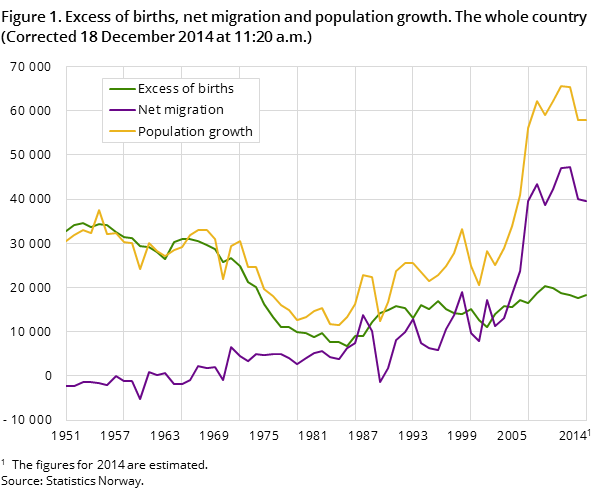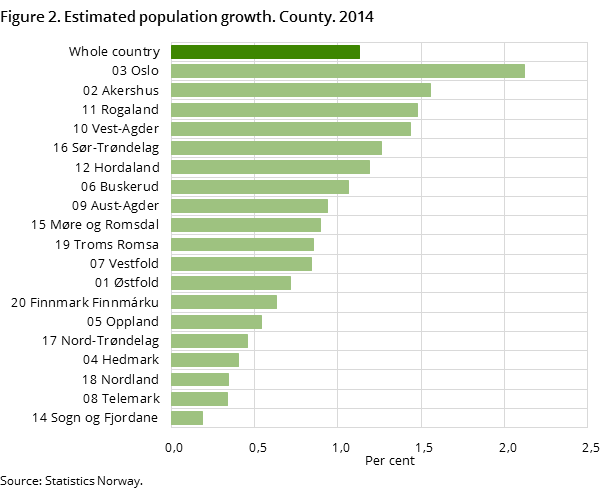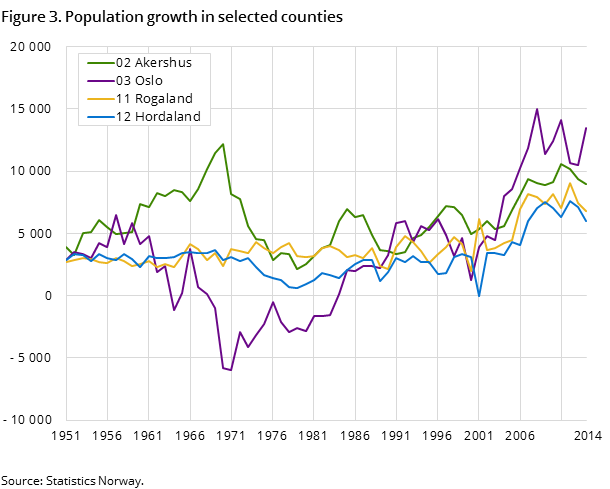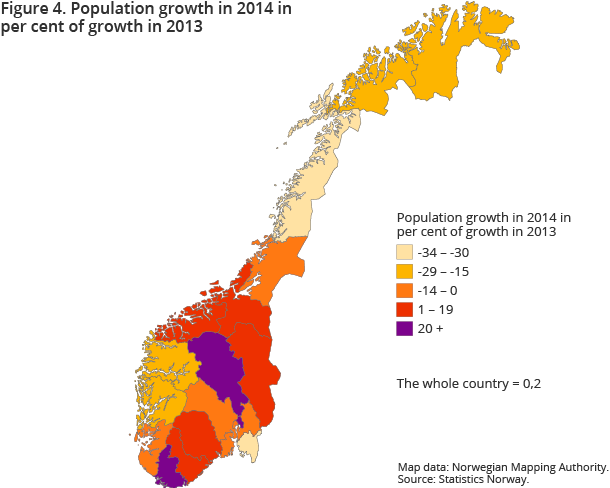Content
Published:
This is an archived release.
Population growth in 2014 similar to 2013
The population of Norway is expected to reach about 5 167 000 persons by the end of 2014. This figure represents a population growth of 57 900 persons. This will be 100 higher than in 2013, but 7 500 lower than the peak year 2011. It is still far higher than in the years prior to 2007, when labour immigration, especially from Poland – but also from other countries – saw a sharp increase.
| 2014 | ||||
|---|---|---|---|---|
| Population 1st January. Final figures | Estimated population growth | Estimated population 31st December | Estimated population growth.Per cent | |
| Corrected 7. January 2015. | ||||
| The whole country | 5 109 056 | 57 913 | 5 166 969 | 1.1 |
| Fredrikstad | 77 591 | 561 | 78 152 | 0.7 |
| Bærum | 118 588 | 2 036 | 120 624 | 1.7 |
| Oslo | 634 463 | 13 447 | 647 910 | 2.1 |
| Drammen | 66 214 | 915 | 67 129 | 1.4 |
| Kristiansand | 85 983 | 1 587 | 87 570 | 1.8 |
| Sandnes | 71 900 | 1 715 | 73 615 | 2.4 |
| Stavanger | 130 754 | 1 406 | 132 160 | 1.1 |
| Bergen | 271 949 | 3 130 | 275 079 | 1.2 |
| Trondheim | 182 035 | 3 025 | 185 060 | 1.7 |
| Tromsø | 71 590 | 1 082 | 72 672 | 1.5 |




Net immigration main reason for population increase
Sixty-eight per cent of the population growth in 2014 will be from a migration surplus from abroad, and 32 per cent will be due to the birth surplus. In the mid 1990s, birth surplus was the main reason for the population growth, constituting almost 70 per cent of the total growth.
An expected migration surplus from abroad of 39 600 will be 500 lower than in 2013, and 3 000 lower than the average for the last seven years, but much higher than it was during the years preceding 2006. Before 1970, some years showed a migration loss to abroad.
A birth surplus of 18 300 will be 600 higher than last year, but 2 100 lower than in the peak year 2009. It is still higher than in the years between 1975 and 2007. For part of the 1980s, the figure was very low, and in 1985 was just 6 750.
Continuing growth in central populated areas, and especially in Oslo
Population growth in the big cities and central areas continues. The counties of Oslo, Akershus, Rogaland and Hordaland combined make up 61 per cent of the growth. Growth in Rogaland and Hordaland in 2014 is expected to be lower than in 2013. However, the growth in Oslo of 10 500 persons in 2013 is expected to increase to 13 400 persons in 2014, which will be the third largest growth ever.
About the estimation Open and readClose
The population is estimated for the country as a whole and at county and municipality level. It is based on information from the population register, using data on births, deaths and migration up to 1 December 2014. The population growth in December is estimated using approximately the same relative growth as in December 2013. If the level of births, deaths and migration changes markedly in December this year compared to last year, the population will vary correspondingly.
For some municipalities, estimated figures as of 1 January 2015 may thus seem to break with the trend so far this year, but this is due to the estimation method used. This is especially visible in small municipalities, where the figures must be regarded as a preliminary estimate.
This page has been discontinued, see Population, Quarterly and Population, Annually, per 1 january.
Contact
-
Magnus Haug
E-mail: magnus.haug@ssb.no
tel.: (+47) 40 81 14 91
-
Karstein Sørlien
E-mail: karstein.sorlien@ssb.no
tel.: (+47) 47 70 16 35
-
Linn Krokedal
E-mail: linn.krokedal@ssb.no
tel.: (+47) 95 47 97 47
-
Anders Sønstebø
E-mail: anders.sonstebo@ssb.no
tel.: (+47) 46 66 37 74
-
Espen Andersen
E-mail: espen.andersen@ssb.no
tel.: (+47) 92 61 00 46
-
Statistics Norway's Information Centre
E-mail: informasjon@ssb.no
tel.: (+47) 21 09 46 42
-
Oppdrag befolkningsstatistikk
E-mail: befolkning@ssb.no
